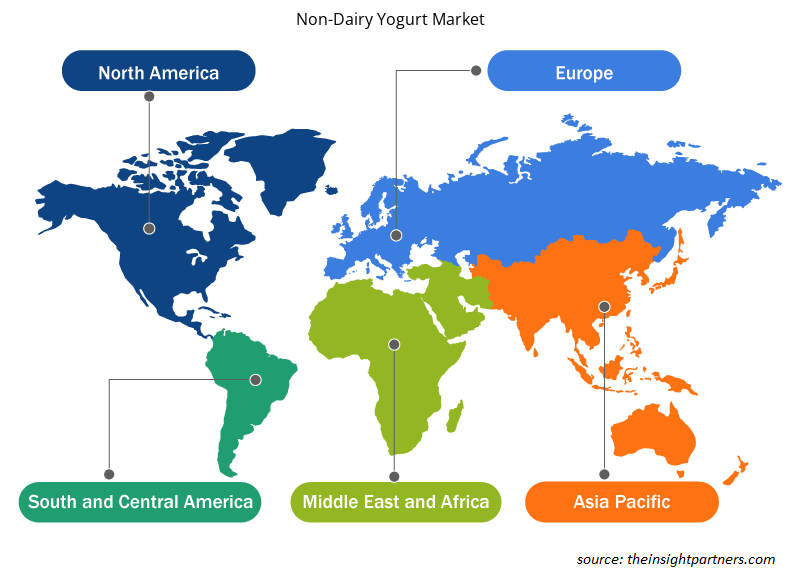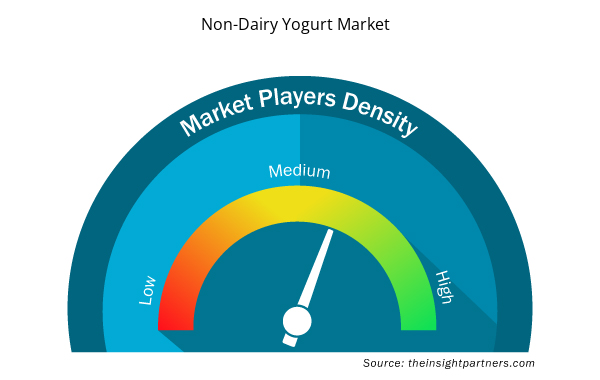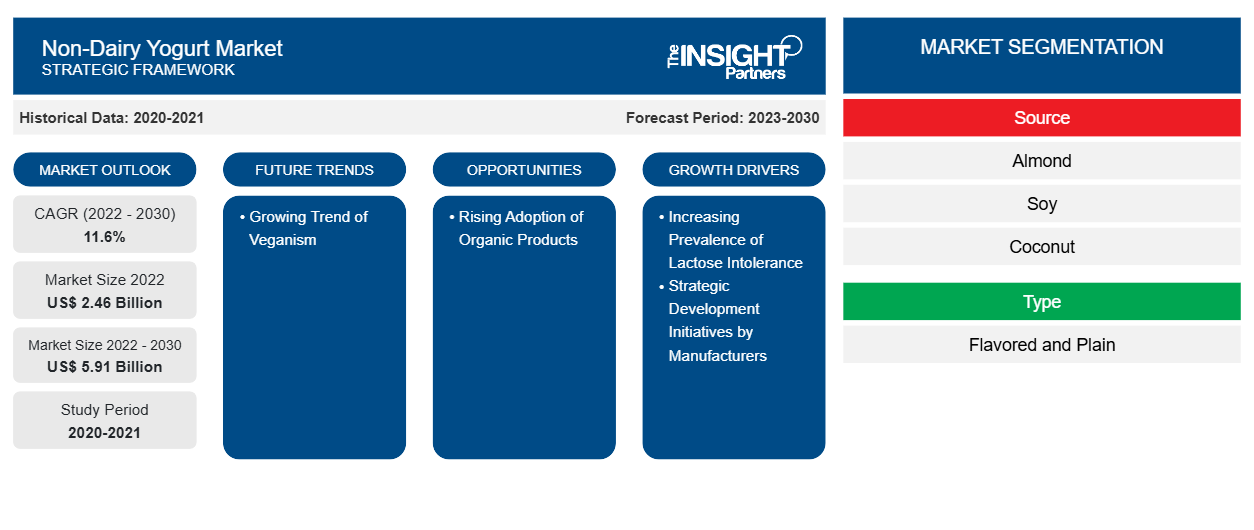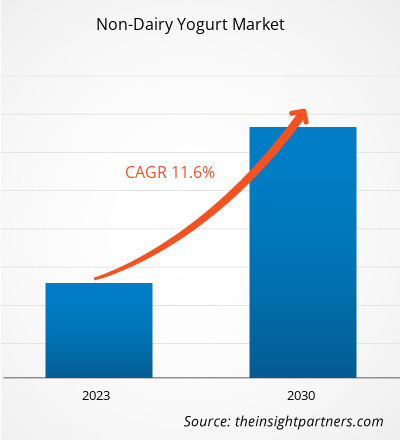[تقرير بحثي] تم تقييم حجم سوق الزبادي غير الألباني بـ 2،458.17 مليون دولار أمريكي في عام 2022 ومن المتوقع أن يصل إلى 5،908.01 مليون دولار أمريكي بحلول عام 2030؛ ومن المتوقع أن يسجل السوق معدل نمو سنوي مركب بنسبة 11.6٪ من عام 2022 إلى عام 2030.
رؤى السوق ووجهة نظر المحلل:
الزبادي غير المصنوع من الألبان هو نوع من الزبادي مصنوع بدون أي مكونات ألبان، مثل الحليب أو ثقافات الزبادي المشتقة من الألبان. بدلاً من ذلك، يتم إنتاجه عادةً من مصادر نباتية مثل حليب اللوز أو جوز الهند أو الصويا أو الكاجو ، وغالبًا ما يحتوي على ثقافات بكتيرية حية توفر عملية تخمير مماثلة للزبادي الألباني التقليدي. يسمح هذا للأشخاص الذين يعانون من عدم تحمل اللاكتوز أو النباتيين أو الذين يتبعون نظامًا غذائيًا خاليًا من منتجات الألبان بالاستمتاع بمنتج يشبه الزبادي بمذاق وملمس مماثلين. يؤدي انتشار عدم تحمل اللاكتوز المتزايد واتجاه النباتية المتزايدة إلى نمو سوق الزبادي غير المصنوع من الألبان في جميع أنحاء العالم.
محركات النمو والتحديات:
الزبادي غير الألباني مصنوع من حليب اللوز وحليب الصويا وحليب جوز الهند، وهي خالية من اللاكتوز. علاوة على ذلك، يتمتع الزبادي النباتي غير الألباني بملمس وكريمة وقوام مماثل للزبادي التقليدي. علاوة على ذلك، يتم تحصين الزبادي النباتي غير الألباني بالبروتين والكالسيوم والعناصر الغذائية الأخرى التي تلبي المتطلبات الغذائية للمستهلكين على أساس يومي. وبالتالي، فإن الانتشار المتزايد لعدم تحمل اللاكتوز وحساسية الحليب بين المستهلكين يعزز نمو سوق الزبادي غير الألباني. علاوة على ذلك، تعتقد الأمم المتحدة ومنظمة بيتا ومعهد الغذاء الجيد والعديد من المنظمات الأخرى أن النباتية يمكن أن تلعب دورًا رئيسيًا في إنقاذ الكوكب من أزمة المناخ. يتزايد الوعي بشأن الآثار السلبية لصناعة الثروة الحيوانية على البيئة بين المستهلكين. يساعد الاستهلاك المتزايد لمنتجات الألبان النباتية في تقليل البصمة الكربونية وتوفير المياه والموارد الطبيعية الأخرى المختلفة وتقليل التأثير الإجمالي على البيئة. وبالتالي، فإن النباتية المتزايدة تدفع نمو السوق. ومع ذلك، فإن تكلفة الزبادي غير المصنوع من الألبان أعلى من تكلفة الزبادي التقليدي بسبب ارتفاع تكلفة المواد الخام وارتفاع نفقات الإنتاج والتسويق. وهذا العامل يمكن أن يعيق نمو سوق الزبادي غير المصنوع من الألبان.
قم بتخصيص هذا التقرير ليناسب متطلباتك
ستحصل على تخصيص لأي تقرير - مجانًا - بما في ذلك أجزاء من هذا التقرير، أو تحليل على مستوى الدولة، وحزمة بيانات Excel، بالإضافة إلى الاستفادة من العروض والخصومات الرائعة للشركات الناشئة والجامعات
- احصل على أهم اتجاهات السوق الرئيسية لهذا التقرير.ستتضمن هذه العينة المجانية تحليلاً للبيانات، بدءًا من اتجاهات السوق وحتى التقديرات والتوقعات.
تقسيم التقرير ونطاقه:
يتم تصنيف سوق الزبادي غير الألباني العالمي على أساس المصدر والنوع والطبيعة وقناة التوزيع والجغرافيا. بناءً على المصدر، يتم تقسيم سوق الزبادي غير الألباني إلى فول الصويا واللوز وجوز الهند والشوفان وغيرها. بناءً على النوع، يتم تقسيم السوق إلى منكه وعادي. من حيث الطبيعة، يتم تقسيم السوق إلى عضوي وتقليدي. بناءً على قناة التوزيع، يتم تصنيف سوق الزبادي غير الألباني إلى محلات السوبر ماركت والهايبر ماركت ومتاجر التجزئة وتجارة التجزئة عبر الإنترنت وغيرها. يتم تصنيف السوق، بناءً على الجغرافيا، إلى أمريكا الشمالية (كندا والولايات المتحدة والمكسيك) وأوروبا (ألمانيا وفرنسا وإيطاليا والمملكة المتحدة وروسيا وبقية أوروبا) وآسيا والمحيط الهادئ (أستراليا والصين واليابان والهند وكوريا الجنوبية وبقية آسيا والمحيط الهادئ) وأمريكا الجنوبية والوسطى (البرازيل والأرجنتين وبقية أمريكا الجنوبية والوسطى) والشرق الأوسط وأفريقيا (المملكة العربية السعودية وجنوب إفريقيا والإمارات العربية المتحدة وبقية الشرق الأوسط وأفريقيا).UAE, and Rest of Middle East & Africa).
التحليل القطاعي:
بناءً على المصدر، يتم تقسيم سوق الزبادي غير الألباني إلى فول الصويا واللوز وجوز الهند والشوفان وغيرها. يشغل قطاع جوز الهند حصة كبيرة من السوق. يتزايد استهلاك المنتجات القائمة على جوز الهند بين المستهلكين مع تفضيل متزايد لبدائل الألبان الصحية . بدائل الألبان القائمة على جوز الهند طبيعية وعضوية وتوفر العديد من الفوائد الصحية للمستهلكين. على سبيل المثال، يساعد حليب جوز الهند في تعزيز صحة القلب والأوعية الدموية الجيدة، وطبيعته العضوية لها خصائص مضادة للالتهابات ومضادة للميكروبات ومضادة للفطريات. وبالتالي، من المتوقع أن تغذي كل هذه العوامل سوق قطاع جوز الهند خلال فترة التنبؤ.
التحليل الإقليمي:
بناءً على الجغرافيا، يتم تصنيف سوق الزبادي غير الألباني إلى خمس مناطق رئيسية - أمريكا الشمالية وأوروبا وآسيا والمحيط الهادئ وأمريكا الجنوبية والوسطى والشرق الأوسط وأفريقيا. هيمنت أوروبا على سوق الزبادي غير الألباني العالمي في عام 2022؛ وبلغت قيمة السوق 922.60 مليون دولار أمريكي. أمريكا الشمالية هي ثاني أكبر مساهم في السوق، والتي تمتلك حوالي 20٪ من السوق العالمية. ومن المتوقع أن تسجل منطقة آسيا والمحيط الهادئ معدل نمو سنوي مركب بنسبة 13.2٪ في سوق الزبادي غير الألباني خلال فترة التوقعات. يشهد سوق الزبادي غير الألباني في منطقة آسيا والمحيط الهادئ نموًا كبيرًا بسبب أنماط الحياة المتغيرة للمستهلكين وزيادة استهلاك المنتجات النظيفة والعضوية والخالية من الغلوتين. كما يخضع السوق في المنطقة لتحول ملحوظ بسبب زيادة التحضر وتنويع النظام الغذائي وإضفاء الشرعية على الاستثمار الأجنبي المباشر في قطاع الأغذية. ومن المتوقع أن تعزز هذه العوامل الطلب على الزبادي غير الألباني في منطقة آسيا والمحيط الهادئ خلال فترة التوقعات.
علاوة على ذلك، تعد أمريكا الشمالية واحدة من أهم المناطق لسوق الزبادي غير المصنوع من الألبان بسبب العدد المتزايد من الأفراد الذين يختارون بدائل أكثر صحة لمنتجات الألبان. وفقًا لبيانات كليفلاند كلينيك، في عام 2019، كان 36٪ من الأمريكيين يعانون من عدم تحمل اللاكتوز. يوضح هذا أن سكان أمريكا الشمالية يفضلون استهلاك المنتجات النباتية، مما يسرع الطلب على المنتجات غير المصنوعة من الألبان مثل الزبادي. مع العدد المتزايد من المستهلكين المهتمين بالصحة، والمخاوف البيئية المتزايدة، والاتجاه المتزايد للأنظمة الغذائية النباتية، أصبح الزبادي النباتي أكثر شعبية في المنطقة.
تطورات الصناعة والفرص المستقبلية:
فيما يلي قائمة بالمبادرات المختلفة التي اتخذها اللاعبون الرئيسيون العاملون في سوق الزبادي غير الألباني:
- في مارس 2022، أطلقت شركة AYO Foods LLC، وهي شركة مقرها الولايات المتحدة، مجموعة جديدة من الزبادي النباتي من خلال تطوير زبادي حليب اللوز العادي بنكهات مختلفة.
- في فبراير 2021، أطلقت شركة Hasla Foods زبادي حليب الشوفان الخالي من السكر بحجم عائلي يبلغ 24 أونصة. يحتوي المنتج على 90 سعرة حرارية فقط لكل وجبة ولا يحتوي على سكر مضاف.
- في يونيو 2021، وسعت شركة Hasla Foods نطاق تجارتها بالتجزئة من خلال توفير منتجاتها في 160 متجرًا من متاجر National Grocers by Vitamin Cottage في الولايات المتحدة.
- في ديسمبر 2020، أطلقت شركة دانون السعودية بديل زبادي حليب اللوز للأطفال، وهو زبادي نباتي تم تركيبه خصيصًا للأطفال. يتكون المنتج من بروتين الفول وحليب اللوز وبكتيريا حية ونشطة وزيت جوز الهند العضوي. وهو غني بفيتامين د والكالسيوم، مما يلبي احتياجات الأطفال الغذائية.
زبادي خالي من الألبان
نظرة إقليمية على سوق الزبادي غير المصنوع من الألبان
لقد قام المحللون في Insight Partners بشرح الاتجاهات والعوامل الإقليمية المؤثرة على سوق الزبادي غير المصنوع من الألبان طوال فترة التوقعات بشكل شامل. يناقش هذا القسم أيضًا قطاعات سوق الزبادي غير المصنوع من الألبان والجغرافيا في جميع أنحاء أمريكا الشمالية وأوروبا ومنطقة آسيا والمحيط الهادئ والشرق الأوسط وأفريقيا وأمريكا الجنوبية والوسطى.

- احصل على البيانات الإقليمية المحددة لسوق الزبادي غير الألباني
نطاق تقرير سوق الزبادي غير الألباني
| سمة التقرير | تفاصيل |
|---|---|
| حجم السوق في عام 2022 | 2.46 مليار دولار أمريكي |
| حجم السوق بحلول عام 2030 | 5.91 مليار دولار أمريكي |
| معدل النمو السنوي المركب العالمي (2022 - 2030) | 11.6% |
| البيانات التاريخية | 2020-2021 |
| فترة التنبؤ | 2023-2030 |
| القطاعات المغطاة | حسب المصدر
|
| المناطق والدول المغطاة | أمريكا الشمالية
|
| قادة السوق وملفات تعريف الشركات الرئيسية |
|
كثافة اللاعبين في سوق الزبادي غير المصنوع من الألبان: فهم تأثيرها على ديناميكيات الأعمال
يشهد سوق الزبادي غير المصنوع من الألبان نموًا سريعًا، مدفوعًا بالطلب المتزايد من جانب المستخدم النهائي بسبب عوامل مثل تفضيلات المستهلكين المتطورة والتقدم التكنولوجي والوعي المتزايد بفوائد المنتج. ومع ارتفاع الطلب، تعمل الشركات على توسيع عروضها والابتكار لتلبية احتياجات المستهلكين والاستفادة من الاتجاهات الناشئة، مما يؤدي إلى زيادة نمو السوق.
تشير كثافة اللاعبين في السوق إلى توزيع الشركات أو المؤسسات العاملة في سوق أو صناعة معينة. وهي تشير إلى عدد المنافسين (اللاعبين في السوق) الموجودين في مساحة سوق معينة نسبة إلى حجمها أو قيمتها السوقية الإجمالية.
الشركات الرئيسية العاملة في سوق الزبادي غير الألباني هي:
- مجموعة هاين سيليستيال المحدودة
- دانون إس إيه
- شركة سبرينغفيلد للكريمة
- شركة ليريكال فودز
- شركة كويو المحدودة
إخلاء المسؤولية : الشركات المذكورة أعلاه ليست مرتبة بأي ترتيب معين.

- احصل على نظرة عامة على أهم اللاعبين الرئيسيين في سوق الزبادي غير المصنوع من الألبان
تأثير كوفيد-19:
أثرت جائحة كوفيد-19 على جميع الصناعات تقريبًا في مختلف البلدان. وأعاقت عمليات الإغلاق والقيود المفروضة على السفر وإغلاق الشركات في أمريكا الشمالية وأوروبا ومنطقة آسيا والمحيط الهادئ وأمريكا الجنوبية والوسطى والشرق الأوسط وأفريقيا نمو العديد من الصناعات، بما في ذلك صناعة الأغذية والمشروبات. وأدى إغلاق وحدات التصنيع إلى اضطراب سلاسل التوريد العالمية وأنشطة التصنيع وجداول التسليم ومبيعات المنتجات الأساسية وغير الأساسية. وشهدت العديد من الشركات تأخيرات في تسليم المنتجات وانخفاضًا في مبيعات منتجاتها في عام 2020.
خلال جائحة كوفيد-19، تغيرت التفضيلات الغذائية للمستهلكين بشكل كبير، حيث تحول العديد من المستهلكين إلى أنظمة غذائية نباتية. زاد الطلب على بدائل الألبان بشكل كبير أثناء الوباء بسبب زيادة المخاوف الصحية والعافية. وبالتالي، نظرًا لارتفاع الوعي الصحي، ارتفع الطلب على الزبادي غير الألباني أثناء الوباء. ومع ذلك، نظرًا لإغلاق وحدات التصنيع، أدى نقص الإنتاج إلى خلق فجوة بين جانبي الطلب والعرض. تلبي الشركات المصنعة ذات مخزونات المنتجات العالية الطلب المتزايد؛ ومع ذلك، تفتقر الشركات المصنعة الصغيرة والمتوسطة الحجم إلى مخزونات المنتجات التي تتكبد خسائر مالية. أثرت هذه العوامل سلبًا على حجم سوق الزبادي غير الألباني.
في عام 2021، استأنفت العديد من الاقتصادات عملياتها بعد أن أعلنت العديد من الحكومات تخفيف القيود المفروضة سابقًا، مما أثر بشكل إيجابي على السوق العالمية. علاوة على ذلك، سُمح للمصنعين بالعمل بكامل طاقتهم، مما ساعدهم على التغلب على فجوة العرض والطلب.
المنافسة والشركات الرئيسية:
تشمل بعض اللاعبين الرئيسيين العاملين في سوق الزبادي غير الألباني العالمي ما يلي:تتبنى شركات Hain Celestial Group Inc، وDanone Sa، وSpringfield Creamery Inc، وLyrical Foods Inc، وCoyo Pty Ltd، وValio Ltd، وOatly Group Ab، وDaiya Foods Inc، وForager Project LLC، وHarmless Harvest Inc. مبادرات التطوير الاستراتيجية للتوسع، مما يؤدي إلى مزيد من نمو السوق.
- التحليل التاريخي (سنتان)، السنة الأساسية، التوقعات (7 سنوات) مع معدل النمو السنوي المركب
- تحليل PEST و SWOT
- حجم السوق والقيمة / الحجم - عالميًا وإقليميًا وقطريًا
- الصناعة والمنافسة
- مجموعة بيانات Excel



Report Coverage
Revenue forecast, Company Analysis, Industry landscape, Growth factors, and Trends

Segment Covered
This text is related
to segments covered.

Regional Scope
North America, Europe, Asia Pacific, Middle East & Africa, South & Central America

Country Scope
This text is related
to country scope.
الأسئلة الشائعة
The major players operating in the global non-dairy yogurt market are The Hain Celestial Group Inc, Danone Sa, Springfield Creamery Inc, Lyrical Foods Inc, Coyo Pty Ltd, Valio Ltd, Oatly Group Ab, Daiya Foods Inc, Forager Project LLC, and Harmless Harvest Inc. among few others.
Consumers prefer products made with natural and ethically sourced ingredients due to a focus on holistic and conscious food consumption. Thus, increasing demand for organically sourced products would create lucrative opportunities for the non-dairy yogurt market during the forecast period.
Based on the source, the coconut segment accounted for the largest revenue share as consumption of coconut-based products among consumers is increasing with a growing preference for healthier dairy alternatives.
Increasing prevalence of lactose intolerance and strategic development initiatives by manufacturers are some of the key driving factors for the non-dairy yogurt market.
Based on category, online is the fastest-growing segment in the non-dairy yogurt market. Online portals such as Amazon, offer various benefits such as home delivery, various secure payment options, attractive discounts, and convenience for customers.
Europe accounted for the largest share of the global non-dairy yogurt market as the popularity of plant-based dairy products is increasing in Europe due to the shift in consumer demand from animal protein to plant protein.
Trends and growth analysis reports related to Food and Beverages : READ MORE..
The List of Companies - Non-Dairy Yogurt Market
- The Hain Celestial Group Inc
- Danone SA
- Springfield Creamery Inc
- Lyrical Foods Inc
- COYO Pty Ltd
- Valio Ltd
- Oatly Group AB
- Daiya Foods Inc
- Forager Project LLC
- Harmless Harvest Inc
The Insight Partners performs research in 4 major stages: Data Collection & Secondary Research, Primary Research, Data Analysis and Data Triangulation & Final Review.
- Data Collection and Secondary Research:
As a market research and consulting firm operating from a decade, we have published and advised several client across the globe. First step for any study will start with an assessment of currently available data and insights from existing reports. Further, historical and current market information is collected from Investor Presentations, Annual Reports, SEC Filings, etc., and other information related to company’s performance and market positioning are gathered from Paid Databases (Factiva, Hoovers, and Reuters) and various other publications available in public domain.
Several associations trade associates, technical forums, institutes, societies and organization are accessed to gain technical as well as market related insights through their publications such as research papers, blogs and press releases related to the studies are referred to get cues about the market. Further, white papers, journals, magazines, and other news articles published in last 3 years are scrutinized and analyzed to understand the current market trends.
- Primary Research:
The primarily interview analysis comprise of data obtained from industry participants interview and answers to survey questions gathered by in-house primary team.
For primary research, interviews are conducted with industry experts/CEOs/Marketing Managers/VPs/Subject Matter Experts from both demand and supply side to get a 360-degree view of the market. The primary team conducts several interviews based on the complexity of the markets to understand the various market trends and dynamics which makes research more credible and precise.
A typical research interview fulfils the following functions:
- Provides first-hand information on the market size, market trends, growth trends, competitive landscape, and outlook
- Validates and strengthens in-house secondary research findings
- Develops the analysis team’s expertise and market understanding
Primary research involves email interactions and telephone interviews for each market, category, segment, and sub-segment across geographies. The participants who typically take part in such a process include, but are not limited to:
- Industry participants: VPs, business development managers, market intelligence managers and national sales managers
- Outside experts: Valuation experts, research analysts and key opinion leaders specializing in the electronics and semiconductor industry.
Below is the breakup of our primary respondents by company, designation, and region:

Once we receive the confirmation from primary research sources or primary respondents, we finalize the base year market estimation and forecast the data as per the macroeconomic and microeconomic factors assessed during data collection.
- Data Analysis:
Once data is validated through both secondary as well as primary respondents, we finalize the market estimations by hypothesis formulation and factor analysis at regional and country level.
- Macro-Economic Factor Analysis:
We analyse macroeconomic indicators such the gross domestic product (GDP), increase in the demand for goods and services across industries, technological advancement, regional economic growth, governmental policies, the influence of COVID-19, PEST analysis, and other aspects. This analysis aids in setting benchmarks for various nations/regions and approximating market splits. Additionally, the general trend of the aforementioned components aid in determining the market's development possibilities.
- Country Level Data:
Various factors that are especially aligned to the country are taken into account to determine the market size for a certain area and country, including the presence of vendors, such as headquarters and offices, the country's GDP, demand patterns, and industry growth. To comprehend the market dynamics for the nation, a number of growth variables, inhibitors, application areas, and current market trends are researched. The aforementioned elements aid in determining the country's overall market's growth potential.
- Company Profile:
The “Table of Contents” is formulated by listing and analyzing more than 25 - 30 companies operating in the market ecosystem across geographies. However, we profile only 10 companies as a standard practice in our syndicate reports. These 10 companies comprise leading, emerging, and regional players. Nonetheless, our analysis is not restricted to the 10 listed companies, we also analyze other companies present in the market to develop a holistic view and understand the prevailing trends. The “Company Profiles” section in the report covers key facts, business description, products & services, financial information, SWOT analysis, and key developments. The financial information presented is extracted from the annual reports and official documents of the publicly listed companies. Upon collecting the information for the sections of respective companies, we verify them via various primary sources and then compile the data in respective company profiles. The company level information helps us in deriving the base number as well as in forecasting the market size.
- Developing Base Number:
Aggregation of sales statistics (2020-2022) and macro-economic factor, and other secondary and primary research insights are utilized to arrive at base number and related market shares for 2022. The data gaps are identified in this step and relevant market data is analyzed, collected from paid primary interviews or databases. On finalizing the base year market size, forecasts are developed on the basis of macro-economic, industry and market growth factors and company level analysis.
- Data Triangulation and Final Review:
The market findings and base year market size calculations are validated from supply as well as demand side. Demand side validations are based on macro-economic factor analysis and benchmarks for respective regions and countries. In case of supply side validations, revenues of major companies are estimated (in case not available) based on industry benchmark, approximate number of employees, product portfolio, and primary interviews revenues are gathered. Further revenue from target product/service segment is assessed to avoid overshooting of market statistics. In case of heavy deviations between supply and demand side values, all thes steps are repeated to achieve synchronization.
We follow an iterative model, wherein we share our research findings with Subject Matter Experts (SME’s) and Key Opinion Leaders (KOLs) until consensus view of the market is not formulated – this model negates any drastic deviation in the opinions of experts. Only validated and universally acceptable research findings are quoted in our reports.
We have important check points that we use to validate our research findings – which we call – data triangulation, where we validate the information, we generate from secondary sources with primary interviews and then we re-validate with our internal data bases and Subject matter experts. This comprehensive model enables us to deliver high quality, reliable data in shortest possible time.


 احصل على عينة مجانية لهذا التقرير
احصل على عينة مجانية لهذا التقرير